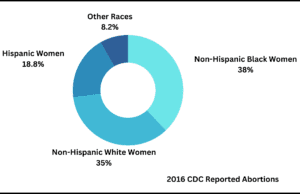The ban on abortions has put Black women in Ohio at risk
Ohio Abortion Law
Abortion clinics near me in Cincinnati
Abortion statistics and access by state
Crisis pregnancy centers
 Abortion laws in Ohio and regulations everywhere are changing. On June 24, 2022, the U.S. Supreme Court ruled 5-4 to Dobbs v. Jackson Women’s Health Organization, overturning Roe v. Wade and making abortions no longer a constitutional right for women. This allows legislators in each state to have the power to determine if abortion is legal and when a woman can terminate her pregnancy.
Abortion laws in Ohio and regulations everywhere are changing. On June 24, 2022, the U.S. Supreme Court ruled 5-4 to Dobbs v. Jackson Women’s Health Organization, overturning Roe v. Wade and making abortions no longer a constitutional right for women. This allows legislators in each state to have the power to determine if abortion is legal and when a woman can terminate her pregnancy.
Receive our newsletter for all things Black Cincinnati!
Although Black people make up 14% of the U.S. population, Black women have the highest reported number of abortions.
- Black women have abortions 3.8 times greater than white women
- Black women have abortions 2.15 times greater than Hispanic women
- Black women have 401 abortions per 1,000 live births
Compared to other races.
- Hispanic women have 156 abortions per 1,000 live births
- White women have 109 abortions per 1,000 live births
- Other women have 207 abortions per 1000 live births
Nationally, in 2016, the CDC reported:
- Non-Hispanic Black women accounted for 38% of all reported abortions
- Non-Hispanic white women accounted for 35% of abortions
- Hispanic women accounted for 18.8% of all reported abortions
- Other races accounted for 8.2% of abortions

Why do Black women have the highest reported number of abortions?
When Alveda King, the niece of Dr. Martin Luther King and chair of the Center for the American Dream at the America First Policy Institute, was asked about the high percentage of Black women accounted for when it came to abortions provided by the CDC, she said, “There is overwhelming evidence that many abortions have been performed to reduce minority populations.”
While evidence of structural racism is documented, other reasons include living in poverty, intimate partner violence, limited access to comprehensive sex education, lower rates of insurance coverage, and more.
Why do women receive abortions?
A national survey of more than 2.4 million women who had abortions performed from 1996 to 2020 estimates hard case abortions.
- 1.14% are done to save the life or physical health of the mother.
- 1.28% to preserve the mental health of the mother.
- 0.39% in cases of rape or incest.
- 0.69% for fetal birth defects
- 3.50% for all the hard cases combined.
- 96.50% of all abortions are performed for social or economic reasons.
Related article: Cincinnati African American doctors accepting new patients.
What does the abortion ban mean for Ohio women?
The Heartbeat Bill, the Ohio ban on abortion, prohibits doctors from performing the procedure once the cardiac activity of the baby is detected. Cardiac detection occurs six weeks into a woman’s pregnancy. Abortions can be performed for up to 24 weeks. If medically necessary, abortions can be performed up until 27 weeks. In 2015, Ohio Black women accounted for 40.7% of abortions in the United States.
Additionally, Ohio attempted to block the six-week abortion plan. Hamilton County Common Pleas Court Judge Christian Jenkins set a hearing for lawyers to explain whether he should grant an initial ban, which could forever block state law banning doctors from performing abortions after the cardiac activity is detected.
Can limited abortion access affect the growth of poverty?
Research shows that abortion is a procedure that helps women’s health and stability, especially young women and Black women. Illegal and limited abortion access would impact disadvantaged women the most. Women in these conditions usually do not have accommodating work policies for maternity leave or access to affordable childcare.
Forbes reported that women who see abortions are three times as likely to be poor.
- 49% are poor, while the national poverty rate is about 12%
- 59% of women who seek abortions are already mothers
- 75% are low-income
- 55% report a recent disruptive life event such as the death of a close friend or family member, job loss, the termination of a relationship with a partner, or overdue rent or mortgage obligations
Studies show that legal abortion access helps.
- Reduced teen motherhood by 34%
- Reduced teen marriage by 20%
- Increased the probability that women facing unintended pregnancies attend college and enter professional occupations
- Black women experienced a 28 to 40% decline in maternal mortality due to abortion legalization.
- Young women who started motherhood by just one year later realized an 11% increase in hourly wages later in their careers.
- Reduced birthrates with a downstream effect of letting families invest in the children they have and for women to manage their work life
Related article: Pregnant women and mothers can see help here.
Where are Ohio abortions performed after six weeks?
For over 100 years, the national organization of Planned Parenthood has been a trusted resource in navigating women’s health and decisions.
Women can visit the AbortionFinder, a directory of trusted and legally verified abortion service providers in the United States.
While Ohioans can currently seek an abortion in their home state, below are the nearest accessible states under a six-hour drive that provide abortions as well.
Click each state to learn more about their abortion legislature.
Are FDA abortion pills legal in Ohio?
The abortion pill, also called medication abortion, is a safe way to terminate a pregnancy and can be used up to 10 weeks of gestation. The abortion pill procedure is self-managed and performed at home during the first trimester.
After approval from the U.S. Food and Drug Administration on January 3, 2023, pharmacies and healthcare providers all over the nation can now sell abortion pulls in person and through the mail. The Mifepristone pill has been deemed safe for persons less than 70 days pregnant.
Reports from the FDA show that more than 3.7 million U.S. women have used mifepristone since it was approved. While complications from the drug are rare, a common side effect is bleeding.
Related article: Let’s talk about your mental health. Start here.
Pharmacies and healthcare providers must become certified to dispense mifepristone and complete a Pharmacy Agreement Form. So far, no pharmacies or healthcare providers in the Cincinnati and Tri-State area have taken the next steps to become certified. Although Planned Parenthood of Southwest Ohio Communication Manager Maya McKenzie confirms that interest has been expressed.
Since the approval, the Mifepristone REMS program has been modified to include the following:
- Mifepristone must be prescribed by a health care provider that meets certain qualifications and is certified under the Mifepristone REMS Program.
- To become certified to prescribe mifepristone, healthcare providers must complete a Prescriber Agreement Form.
- The Patient Agreement Form must be reviewed and signed by the patient and the health care provider. The risks of the mifepristone treatment regimen must be fully explained to the patient before mifepristone is prescribed.
- The patient must be provided with a copy of the Patient Agreement Form and mifepristone Medication Guide (FDA-approved information for patients).
- Mifepristone may only be dispensed by or under the supervision of a certified prescriber or by a certified pharmacy on a prescription issued by a certified prescriber.
- To become certified to dispense mifepristone, pharmacies must complete a Pharmacy Agreement Form.
- Certified pharmacies must be able to ship mifepristone using a shipping service that provides tracking information.
- Certified pharmacies must ensure mifepristone is dispensed to the patient promptly.
Please note the FDA does not recommend buying the Mifepristone pill online, where it cannot be regulated.
How much does an abortion cost in Ohio?
Planned Parenthood reports that abortion can cost up to $750 in the first trimester and up to $1,500 later in the pregnancy. Of course, this depends on a few things, including the city/state you live in, insurance, income, financial support programs in your area, and the type of abortion one receives.
Ohio Medicaid is 1 of 33 states that follow the federal standard and provide abortions in life endangerment, rape, and incest cases. Visit Ohio Medicaid online or call 1-800-324-8680 for more information.
The Midwest Action Coalition is an abortion fund that helps pregnant women traveling to, from, or within the Midwest to access safe and legal abortion services. They do not pay for the abortion but can help with travel, accommodations, food, medication, and childcare costs.
Related article: Black self-help books to expand your thinking.
How does pregnancy affect Black women?
The delivery room can be scary for Black women who experience life-threatening complications. As a result, Black women are three to four times more likely to die from pregnancy-related causes than their white counterparts. The cause of this disparity is the lack of access and poor-quality care among women at lower socioeconomic levels. Therefore, Black women are undervalued due to dismissing health concerns and untreated symptoms.
Above all, Black women should seek the professional comfort and skill of a Black OB-GYN and professional team. View this list of Black OB-GYNs accepting new patients in the Cincinnati area.
With or without insurance, Cincinnati Black women can also contact the Cincinnati Health Department to make an appointment with a local physician to be referred to an OB-GYN.

While state governments continue to change the language and policies around the law of abortion, including the Ohio abortion law, hopefully, this information can guide your research about what you need to know and how to govern your own body. Before you make any decisions, please consult with a medical professional.
Written by: Marissa Staples
The Voice of Black Cincinnati is a media company designed to educate, recognize, and create opportunities for African Americans. Want to find local news, events, job posting, scholarships, and a database of local Black-owned businesses? Visit our homepage, explore other articles, subscribe to our newsletter, like our Facebook page, join our Facebook group, and text VOBC to 513-270-3880.
Ohio Abortion Law images provided by AdobeStock